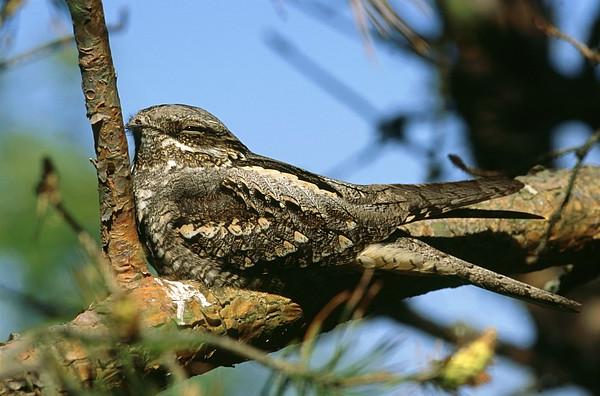Listen for Nightjar
Reports

Hearing a Nightjar used to be a not uncommon experience in Arran, but in the latter part of the twentieth century there was a decline. In 1980, nine churring Nightjar were reported from Merkland. In 1984, eight pairs were reported but the rest of the 1980s show a decline with four or five pairs in 1985 and three or four pairs in 1987 and one calling male in 1988. Single birds continued to be reported mainly in the Merkland area until 1995. In 1996 there no reports from Merkland but two from elsewhere. The last report in 1990s was one in 1998 at Maol Donn. There was then a gap with no records until 2013 when one was calling at Merkland from 17 June to 26 June. Since then there has been one record in 2017.
With the extensive clear-felling being done in Scotland by Forestry and Land Scotland it is hoped that the increase in more suitable open heath type habitat adjacent to woodland may result in resurgence of this species. The increase of these areas in Arran may encourage the re-establishment of the Nightjar. These new areas provide good nesting cover, plenty of perches and an abundant food supply.
This is the time of year to get out and listen for them. Nightjars are birds of legend including the widely held belief that Nightjars sucked the milk of grazing animals. Thus its other name “Goatsucker”. In reality, Nightjars feed on insects, mainly larger moths. Nightjars migrate to Britain from Africa and return there after rearing their chicks. They arrive in Scotland in late May and early June when the moth population explodes. They are most active at the same times of day as moths, at dawn and at dusk. With their large eyes, huge gape surrounded by “whiskers” they are well adapted for catching their prey.
Nightjars are rarely seen during daylight but this remarkable piece of video on the left captures Nightjar churring in daylight. Normally during the day they remain motionless on the ground, relying on their amazing camouflage - feather patterns that look like dead leaves and old tree bark - to avoid detection. But at night when they are 'churring', they usually perch on the branch of a prominent tree and can be picked out against the night sky as in this video on the right.
It is this distinctive sound that you should listen out for in June. Males perform this prolonged churring call ('Nightjar' means night-churr) that may go on for several minutes, varying in pitch and volume. When the birds stop churring, they are often in flight and two other sounds are frequently heard. The first is a rather soft 'coohwick' given as a single note and thought to be a contact call. The second is a slapping or hand-clapping sound caused as the birds clap their wings in flight. When flying, Nightjar swoop and flap around their territories, often coming very close to any observers. Males have prominent white markings on the wings and tail, and females have brown markings that are much less prominent. These stand out even at night, so it is often possible to identify the bird's sex.
Encountering Nightjar in the gloaming is a magic birding moment, if you can thole the inevitable midges.
If you hear Nightjar calling on Arran, I would appreciate it if you would take a moment to let me know "where and when".